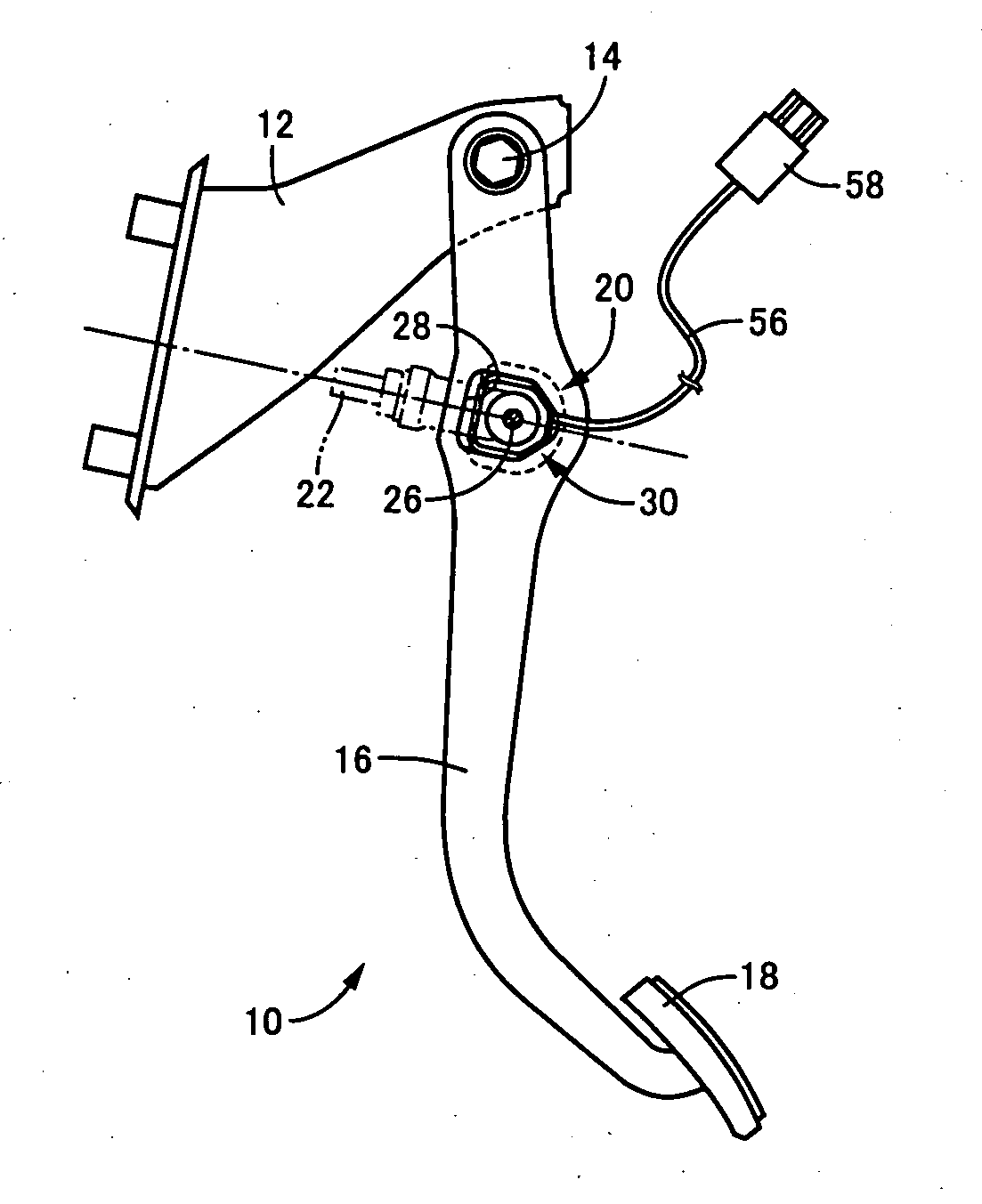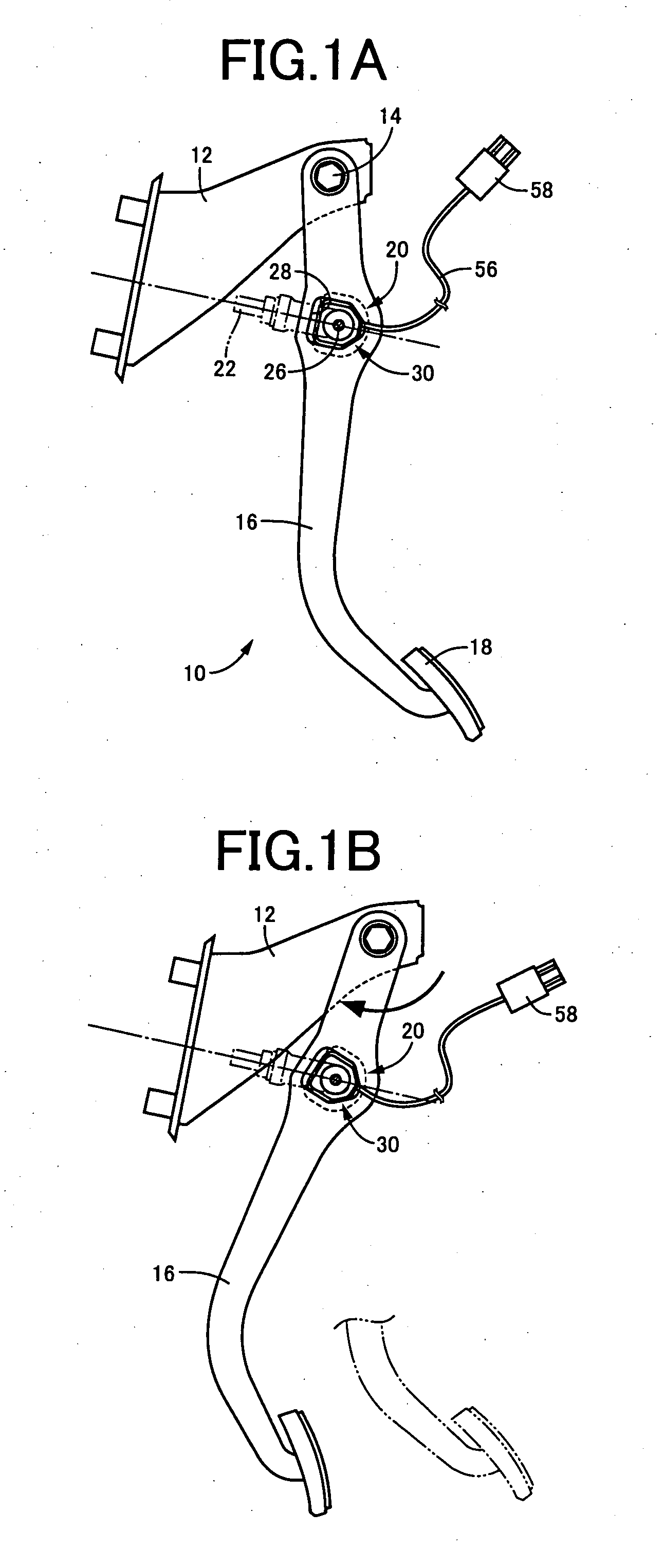Load-sensor-equipped vehicle operating pedal device and load-sensor-equipped operating device
a technology of operating pedal and load sensor, which is applied in the direction of mechanical control devices, instruments, force/torque/work measurement apparatus, etc., can solve the problems of increasing the size of the device as a whole, the device becomes complicated in its structure, and the usual pushrod cannot be used intact, so as to reduce the amount of deformation (strain value), reduce the flexure deformation of the case member, and increase the detection precision of the operating force
- Summary
- Abstract
- Description
- Claims
- Application Information
AI Technical Summary
Benefits of technology
Problems solved by technology
Method used
Image
Examples
embodiment 1
[0119]FIGS. 1A and the 1B are views showing an operating pedal device 10 of one embodiment according to the present invention for a service vehicle brake. FIG. 1A shows an operating pedal 16 in a state depressed to an intermediate point of a depressing stroke, and FIG. 1B shows another state of the operating pedal 16 that is further depressed to a terminal end of the depressing stroke. The vehicle operating pedal device 10 represents a case in which the present invention is applied to the operating pedal device 200 shown in FIGS. 21A and the 21B. The operating pedal 16 is formed a sensor-mounting hole 28 for mounting a load sensor 30 therein.
[0120]Like the load sensor 204 described above, the load sensor 30 has the wire harness 56 having a distal end coupled to a connector 58, through which the wire harness 56 is connected to a control circuit section of a vehicle. The operating pedal device 10 corresponds to a claimed operating device, and the operating pedal 16 corresponds to a cl...
embodiment 2
[0164]FIGS. 9A and the 9B are views corresponding to FIGS. 1A and 1B. FIG. 9A shows a state with a depressing stroke placed at an intermediate point thereof, and FIG. 9B shows another state with the depressing stroke placed at a final stage thereof. A vehicle operating pedal device 80 includes an intermediate lever 82, through which the operating force is transmitted from the operating pedal 16 to the operating rod 22.
[0165]The intermediate lever 82 has one longitudinal end pivotably mounted on the pedal support 12 by means of a support pin 84 extending parallel to the support shaft 14, and a longitudinally intermediate portion pivotably connected to the operating pedal 16 via a connecting link 86. This allows the intermediate lever 82 to be pivoted about the support pin 84 mechanically in conjunction with depression of the operating pedal 16. The connecting link 86, has both longitudinal ends pivotably relatively connected to the operating pedal 16, and the intermediate lever 82 vi...
embodiment 3
[0168]A load sensor 100 shown in FIG. 10 has the same fundamental structure as that of the embodiments set forth above, and includes the strain body 32, the case member 34 and the shaft-like member 36. However, the four strain resistance elements 102a to 102d placed in positions different from those of the embodiments described above. That is, the four strain resistance elements 102a to 102d are disposed in four area, demarcated with the neutral plane S and another plane passing across the axis, i.e., the centerline O, of the strain body 32 to be perpendicular to the neutral plane S, in a symmetrically positional relationship with respect to the neutral plane S. More particularly, the four strain resistance elements 102a to 102d are placed at four positions on the strain body 32 by approximately 90° so as to intersect with two straight lines passing across the centerline O (axis Q) of the sensor while crossing the neutral plane S at an angle of approximately 45°. The central positio...
PUM
 Login to View More
Login to View More Abstract
Description
Claims
Application Information
 Login to View More
Login to View More - R&D
- Intellectual Property
- Life Sciences
- Materials
- Tech Scout
- Unparalleled Data Quality
- Higher Quality Content
- 60% Fewer Hallucinations
Browse by: Latest US Patents, China's latest patents, Technical Efficacy Thesaurus, Application Domain, Technology Topic, Popular Technical Reports.
© 2025 PatSnap. All rights reserved.Legal|Privacy policy|Modern Slavery Act Transparency Statement|Sitemap|About US| Contact US: help@patsnap.com



